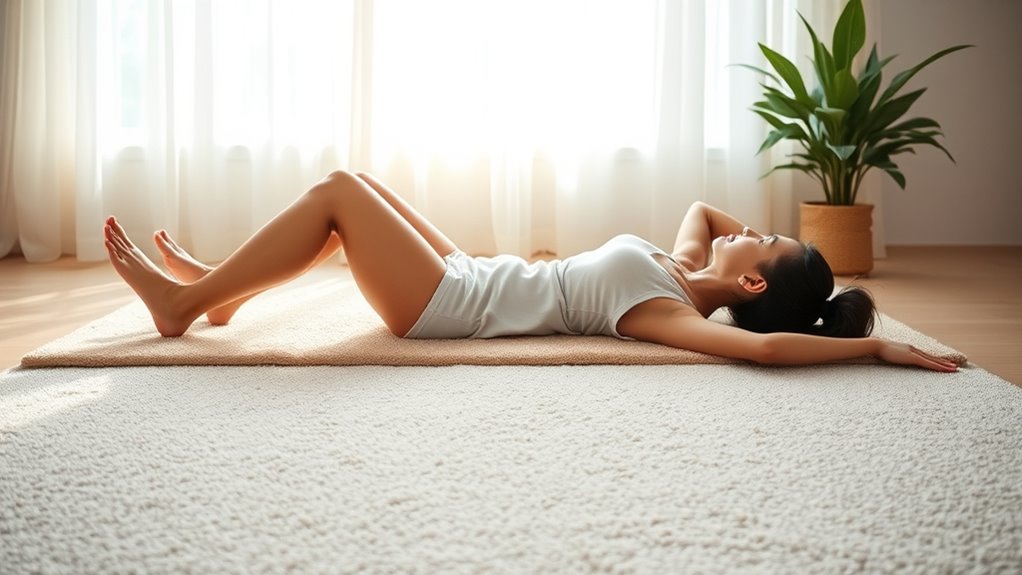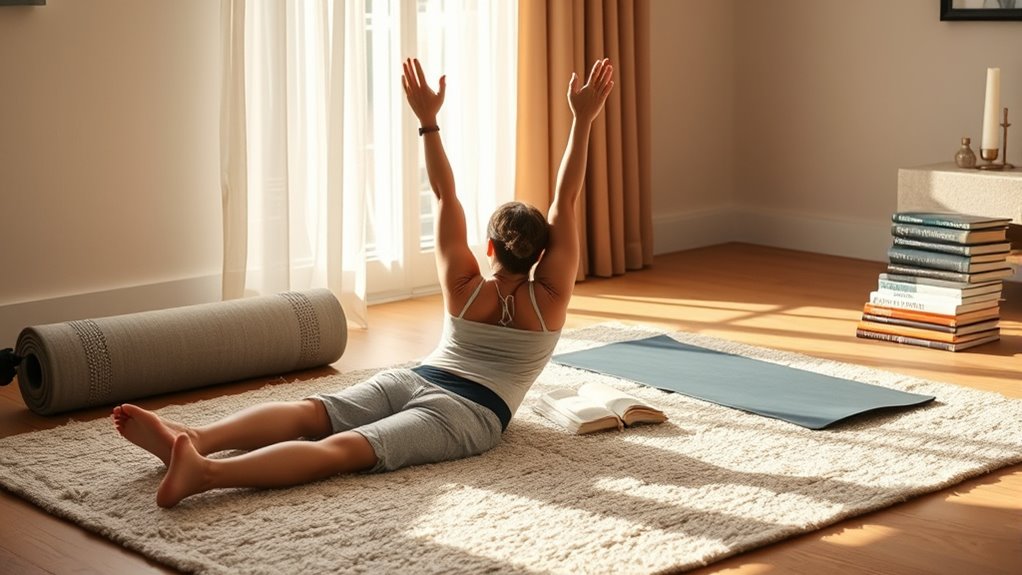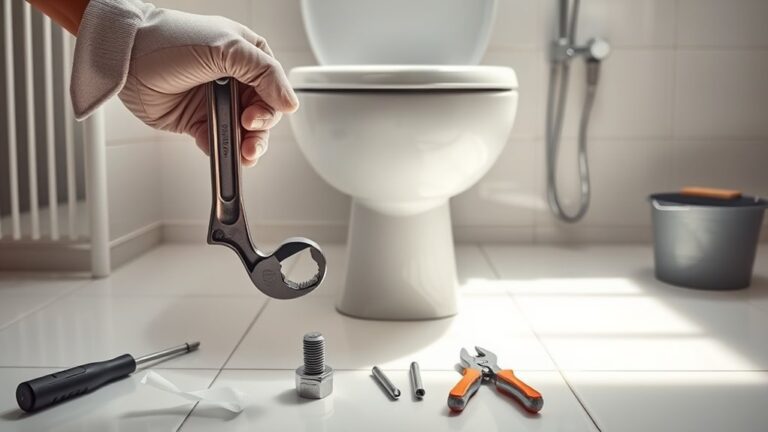Lying on the floor gives your back firm, even support that helps keep your spine naturally aligned, reducing strain on muscles and vertebrae. It eases muscle tension and promotes relaxation by preventing uneven sinking that soft surfaces cause. This simple practice can improve your posture, relieve lower back pain, and encourage better core muscle engagement when done safely. If you want to understand the best techniques and frequency for maximum benefit, there’s more to explore ahead.
The Science Behind Spinal Alignment on a Firm Surface

Although it might seem simple, lying on a firm surface plays an essential role in maintaining proper spinal alignment. When you lie on soft mattresses or couches, your spine can sink unevenly, disrupting natural spinal mechanics. Firm surfaces provide a stable foundation, allowing your spine to rest in a neutral position, which supports its natural curves without strain. This alignment reduces stress on your vertebrae and surrounding muscles, helping prevent discomfort and long-term issues. By choosing firm surfaces, you give your back the freedom it needs to maintain its healthy structure effortlessly. Understanding this connection empowers you to make choices that support your back’s health and enhance your overall sense of well-being, promoting freedom from pain and stiffness.
How Lying on the Floor Reduces Muscle Tension
When you lie on the floor, your spine experiences less compression, which helps ease muscle tension. This position allows tight muscles to relax naturally by supporting your body evenly. As a result, your back can settle into its natural alignment, reducing discomfort and promoting ease.
Eases Spinal Compression
Since your spine supports your entire body, it’s no surprise that it can become compressed from daily activities like sitting or standing for long periods. Lying on the floor offers a simple yet effective way to encourage spinal decompression. When you lie flat, the natural weight of your body gently stretches your spine, reducing the pressure between your vertebrae. This eases discomfort and promotes better alignment. The floor benefits extend beyond just support—it provides a firm, even surface that prevents your spine from sinking unevenly, which often happens on soft beds or chairs. By regularly spending time lying on the floor, you give your spine a chance to decompress, helping you regain freedom of movement and reduce chronic back tension. It’s a small habit with powerful results.
Relaxes Tight Muscles
Along with easing spinal compression, lying on the floor helps relax tight muscles that often contribute to back pain. When you settle onto a firm, flat surface, your muscles aren’t forced to compensate for uneven support, which reduces muscle tension naturally. This position encourages your muscles to loosen, allowing you to experience a sense of relief without extra effort. Incorporating this simple relaxation technique into your routine can be a powerful way to ease discomfort and promote freedom of movement. By combining lying on the floor with other relaxation techniques like deep breathing or gentle stretches, you can further release muscle tightness and support overall back health. This approach gives you a practical, accessible way to manage muscle tension daily.
Enhances Natural Alignment
Although it might seem simple, lying on the floor can greatly enhance your spine’s natural alignment, which in turn reduces muscle tension. When you position yourself flat against a firm surface, your body naturally aligns without the distortions often caused by soft mattresses or poor posture. This floor positioning supports the natural curves of your spine, allowing muscles to release unnecessary strain. The alignment benefits you gain help prevent chronic discomfort and improve your overall posture over time. By embracing this straightforward practice, you give your body the chance to reset, promoting freedom of movement and reducing tension. It’s a small, accessible step that can make a significant difference in how your back feels and functions daily.
Benefits for Posture Improvement
Lying on the floor helps support your spine’s natural alignment, which is key for improving posture. It also encourages your muscles to relax, reducing the strain that often leads to poor posture habits. By making this a habit, you’ll give your body a better chance to maintain healthy positioning throughout the day.
Spinal Alignment Support
One simple way to support your spinal alignment is by spending time lying flat on the floor, which helps your body reset its natural posture. When you lie on a firm, even surface, your spine can align properly without the interference of soft cushions or uneven support. This position encourages spinal health by reducing unnecessary pressure points and allowing the vertebrae to find their best placement. Incorporating floor exercises into your routine can further enhance this effect, promoting better posture and long-term alignment. By regularly giving your back this grounded support, you allow your muscles and spine to work together more effectively, which can free you from stiffness and discomfort. Embracing this simple practice empowers you to maintain a healthy, aligned spine in everyday life.
Muscle Relaxation Benefits
Because your muscles tend to hold tension throughout the day, allowing them to fully relax while lying on the floor can greatly improve your posture. When you take this simple step, you promote muscle recovery and experience stress relief, which is essential for freeing your body from habitual tightness. Here’s how muscle relaxation benefits your posture:
- Releases built-up tension in back and neck muscles.
- Encourages balanced muscle engagement for better alignment.
- Reduces stiffness, making it easier to maintain an upright posture.
- Enhances blood flow, speeding up muscle recovery and reducing discomfort.
Impact on Lower Back Pain Relief

Although it might seem unconventional, placing yourself flat on the floor can greatly reduce lower back pain by promoting proper spinal alignment. When you lie on a firm surface, your spine naturally finds its neutral position, relieving pressure on discs and muscles that often cause discomfort. This simple practice complements lower back exercises and daily stretching, enhancing your overall pain management routine. By incorporating floor lying into your day, you give your back the chance to relax and reset, which can improve flexibility and reduce stiffness. You don’t have to rely solely on medication or complex therapies—just a few minutes on the floor can make a noticeable difference, empowering you to move freely and live without constant pain weighing you down.
The Role of Floor Lying in Core Muscle Activation
Core muscle activation plays an essential role in maintaining a healthy back, and lying on the floor can help you engage these muscles effectively. When you lie flat, your body naturally aligns, promoting ideal pelvic positioning. This alignment challenges your core muscles to maintain stability without extra support, enhancing core stability over time. Here’s how floor lying benefits your core activation:
Lying flat aligns your body and activates core muscles, fostering better pelvic control and back health.
- Encourages awareness of pelvic tilt, improving control.
- Stimulates deep abdominal muscles that support the spine.
- Reduces compensatory muscle tension by promoting balanced activation.
- Provides a neutral base to practice controlled breathing and movement.
Comparing Floor Lying to Other Back Care Practices

Engaging your core muscles by lying on the floor sets a solid foundation for back health, but you might wonder how this practice stacks up against other common methods. Unlike some back care routines that require equipment or gym visits, floor exercises and simple lying techniques offer accessibility and ease. They allow you to connect with your body in a natural, low-impact way, promoting spinal alignment and core strength without strain. While activities like stretching or targeted physical therapy are beneficial, floor lying emphasizes stability and relaxation simultaneously, making it a unique complement to your back care regimen. Embracing these techniques can give you greater control over your back health, fostering freedom in movement and reducing discomfort with minimal effort and maximum benefit.
Safe Techniques for Lying on the Floor
When you lie on the floor to support your back, it’s important to do so with proper technique to avoid strain or discomfort. Ensuring safe positioning and choosing supportive surfaces play key roles in maximizing benefits. Here’s how you can practice this safely:
- Pick a firm, flat surface—avoid overly hard floors by placing a thin mat or towel underneath.
- Lie on your back with your knees bent and feet flat on the floor to maintain natural spine alignment.
- Use a small pillow or rolled towel under your neck for gentle support without elevating your head too much.
- Keep your arms relaxed at your sides or rest them comfortably across your abdomen.
How Often and How Long Should You Lie on the Floor?
How often and how long you should lie on the floor depends on your individual needs and comfort level. Frequency recommendations typically suggest starting with short sessions, around 5 to 10 minutes, once or twice daily. This allows your body to adjust without strain. Duration guidelines encourage gradually increasing time as you feel more comfortable, but it’s important not to overdo it. Listening to your body is key; if you experience discomfort or pain, reduce the frequency or duration. Consistency matters more than extended sessions, so regular, manageable intervals can promote spinal alignment and relieve tension effectively. Remember, lying on the floor is a tool to support your back’s freedom, and tailoring frequency recommendations and duration guidelines to your lifestyle guarantees you benefit safely and sustainably.




